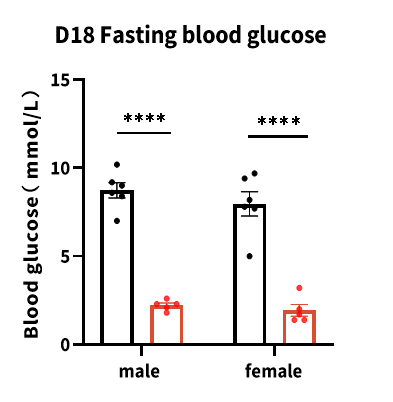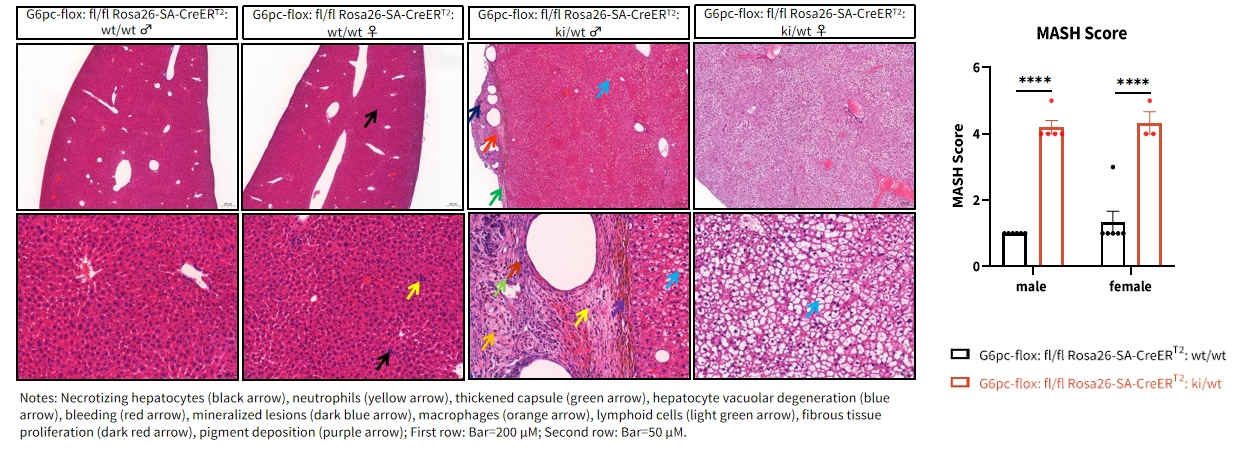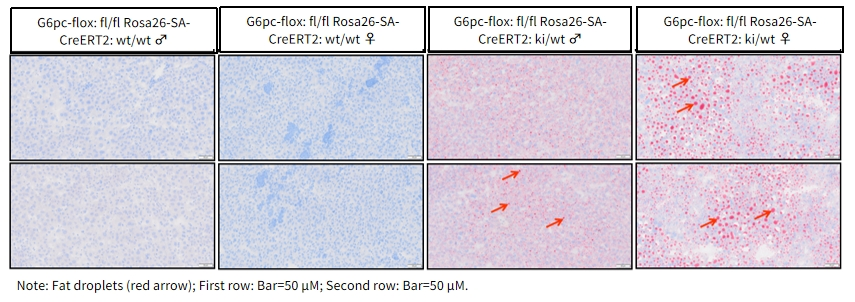Glycogen storage disease type I (GSDI), a group of rare inherited disorders, results from a defect in the glucose-6-phosphatase (G6Pase) system, which is crucial for glucose homeostasis. It has two well-defined main subtypes: GSD type Ia (GSDIa), caused by a defect in the catalytic unit glucose-6-phosphatase-alpha (G6PC), and GSD type Ib (GSDIb), due to a defect in the glucose-6-phosphate translocase (G6PT). The main diagnostic criteria include hepatomegaly, fast-induced hypoglycemia accompanied by hyperlactacidemia, and hyperlipidemia. With an annual incidence of around 1 in 100,000 births, GSDIa is the most common type, accounting for about 80% of GSDI patients.
● Induced GSDIa Mouse Model
Strain Name | Strain Type | Description |
T008830 B6-G6pc-flox × T050182 Rosa26-SA-CreERT2 or T017784 H11-Alb-CreERT2 | Inducible, systemic or liver-specific conditional knock-out | Conditional knockout of G6PC by 6 weeks of age leads to premature death of the mice within 4 weeks, with reduced blood glucose, increased liver and kidney indexes, impaired lipid metabolism, and development of fatty-acid liver and MASH-like phenotype, which mimic human GSD1a patients. |
G6pc-flox | NO. T008830 × Rosa26-SA-CreERT2 | NO. T050182 (Systemic conditional G6pc knockout mice)
1. Fasting blood glucose

2. Survival of male mice

Mice receive 100 mg/kg/d tamoxifen injections for 7 days, beginning at 6 weeks of age. The day of tamoxifen injection is denoted as D1. G6pc-flox: fl/fl Rosa26-SA-CreERT2: ki/wt mouse display decreased fasting blood glucose and premature death after tamoxifen induction. (Rosa26-SA-CreERT2 wt/wt: n=12; Rosa26-SA-CreERT2 ki/wt: n=9. Mixed gender).
3. Liver, Kidney/Body weight at Day 21

G6pc-flox: fl/fl Rosa26-SA-CreERT2: ki/wt mouse display significantly increased liver and kidney indexes.
4. Plasma biochemistry results at Day 21 male mice

G6pc-flox: fl/fl Rosa26-SA-CreERT2: ki/wt mouse display significantly increased plasma ALT, AST, CREA and CHOL levels.
5. Liver H&E staining and NASH Score

Compared with control mice, G6pc-flox: Rosa26-SA-CreERT2: ki/wt mice displayed liver damage, fibrosis, increased lipid deposition, and increased MASH score.
6. Liver Oil Red O Staining

Compared with the control groups, G6pc-flox: Rosa26-SA-CreERT2: ki/wt mice displayed liver lipid deposition, as indicated by significantly increased oil red O staining signal.

